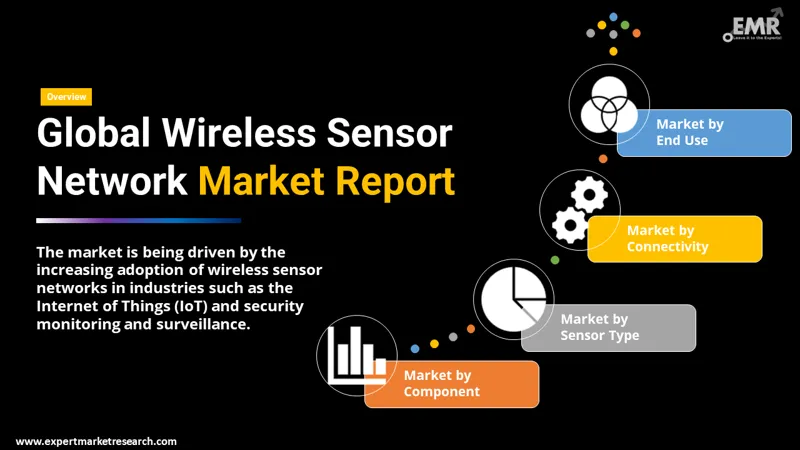
Consumer Insights
Uncover trends and behaviors shaping consumer choices today
Procurement Insights
Optimize your sourcing strategy with key market data
Industry Stats
Stay ahead with the latest trends and market analysis.
The global wireless sensor network market is likely to expand at a CAGR of 17.20% during 2026-2035. Wireless sensor networks are being increasingly employed for a broad range of uses. These intelligent monitoring networks allow for greater operational transparency, and enable data analytics, assisting strategic decision making. Asia, Europe and North America are likely to be significant markets.
Base Year
Historical Period
Forecast Period
Compound Annual Growth Rate
17.2%
2026-2035
*this image is indicative*
Wireless sensor network (WSN) refers to an infrastructure-free, self-configured wireless network used in several wireless sensors (as needed) to observe environmental or physical parameters like sound, temperature, pressure, motion, vibration, or contaminants, and to supportively pass information to a key site or sink to be analysed. Sensor nodes are employed in wireless sensor network (WSN) with the onboard processor that observes and manages surroundings in a given area. These are linked to the Base Station (linked by internet to share information) which functions as a processing unit in the wireless sensor network (WSN) system.

Read more about this report - REQUEST FREE SAMPLE COPY IN PDF
Sensors today have become almost all-pervading. For example, sensors in residential buildings detect fire, occupancy, smoke, temperature, and enable security; modern vehicles come equipped with many sensors that monitor performance of engine, brakes, and safety equipment, to name a few; in manufacturing, sensors enable production of safe and quality products. With time, sensors have reduced in size, become more cost-effective, and less- power consuming. Domains that use wireless sensor networks (WSNs) include industrial regulation; building, industrial process, and home automation; smart grid and automated metering infrastructure (AMI); monitoring environmental and energy parameters; transit and parking infrastructure, and inventory control.
Applications of wireless sensor network (WSN) include Internet of Things (IOT); Security Monitoring and Surveillance; Environmental Aspects like and Air Pressure, Humidity, Temperature; Surrounding Noise Levels; Medical Applications; Landslide Identification; Agriculture; and others. Constituents of wireless sensor network (WSN) include sensors, radio nodes, WLAN access point, and evaluation software.
Wireless sensor network (WSN) technology has been successfully applied in multiple domains. These applications are expected to boost the global wireless sensor network (WSN) market. Chief applications include:
Military – Military command, communications, control, intelligence, computing, surveillance, battlefield, recce and targeting systems.
Area monitoring – Sensor nodes installed over an area to monitor an event detect essential parameters such as pressure, heat, etc. report the event to a base-station for suitable action.
Transportation – Real-time traffic data are gathered by wireless sensor network (WSN) systems to feed transportation models and notify reasons of congestion and traffic problems.
Health applications – Several systems support interfaces for the disenabled, integrated patient monitoring, drug administration in hospitals, diagnostics, etc.
Environmental sensing – Sensing oceans, volcanoes, forests, glaciers, etc.
Other key domains include Internet of Things (IoT), air pollution monitoring, threat detection, forest fire detection, video surveillance, robotic control, greenhouse monitoring, landslide detection, structural monitoring, industrial monitoring, agriculture, and others.

Read more about this report - REQUEST FREE SAMPLE COPY IN PDF
The EMR’s report titled “Wireless Sensor Network Market Report and Forecast 2026-2035" offers a detailed analysis of the market based on the following segments:
By component, the market is segmented into:
By sensor type, the market is divided into:
By connectivity, the market is classified into:
By end use, the market is divided into:
By region, the market is classified into:
The report comprehensively analyses significant players in the global wireless sensor network market, evaluating their capacity and observing newest developments like plant turnarounds, capacity expansions, and mergers and acquisitions; significant players include:
The EMR report offers deep insights into the industry through a SWOT analysis and Porter’s Five Forces model.




*While we strive to always give you current and accurate information, the numbers depicted on the website are indicative and may differ from the actual numbers in the main report. At Expert Market Research, we aim to bring you the latest insights and trends in the market. Using our analyses and forecasts, stakeholders can understand the market dynamics, navigate challenges, and capitalize on opportunities to make data-driven strategic decisions.*
Get in touch with us for a customized solution tailored to your unique requirements and save upto 35%!
The global wireless sensor networks market is estimated to grow at a CAGR of 17.20% between 2026 and 2035.
The major market drivers are the increasing usage of wireless sensor networks in various industries like the Internet of Things (IoT) and security monitoring and surveillance.
The key market trends include technological advancement, along with increasing disposable income and surging automation of devices.
The major regions in the market are North America, Europe, the Asia Pacific, Latin America, and the Middle East and Africa.
The various components of wireless sensor networks in the market include services, software, and hardware.
The various sensor types of wireless sensor networks in the market include CMOS-based sensors, MEMS sensors, LED sensors, motion and position sensors, among others.
The various connectivities of wireless sensor networks in the market include Wireless HART, ZigBee, Wi-Fi, IPv6, and Bluetooth, among others.
The different end-uses of wireless sensor networks in the market are building automation, oil and gas, healthcare, aerospace and defence, automation and transportation, and industrial, among others.
The major players in the market are Emerson Electric Co., Cisco Systems Inc., Analog Devices, Inc., Radiocrafts AS, and NXP Semiconductors N.V., among others.
Explore our key highlights of the report and gain a concise overview of key findings, trends, and actionable insights that will empower your strategic decisions.
| REPORT FEATURES | DETAILS |
| Base Year | 2025 |
| Historical Period | 2019-2025 |
| Forecast Period | 2026-2035 |
| Scope of the Report |
Historical and Forecast Trends, Industry Drivers and Constraints, Historical and Forecast Market Analysis by Segment:
|
| Breakup by Component |
|
| Breakup by Sensor Type |
|
| Breakup by Connectivity |
|
| Breakup by End Use |
|
| Breakup by Region |
|
| Market Dynamics |
|
| Competitive Landscape |
|
| Companies Covered |
|
Datasheet
One User
USD 2,499
USD 2,249
tax inclusive*
Single User License
One User
USD 3,999
USD 3,599
tax inclusive*
Five User License
Five User
USD 4,999
USD 4,249
tax inclusive*
Corporate License
Unlimited Users
USD 5,999
USD 5,099
tax inclusive*
*Please note that the prices mentioned below are starting prices for each bundle type. Kindly contact our team for further details.*
Flash Bundle
Small Business Bundle
Growth Bundle
Enterprise Bundle
*Please note that the prices mentioned below are starting prices for each bundle type. Kindly contact our team for further details.*
Flash Bundle
Number of Reports: 3
20%
tax inclusive*
Small Business Bundle
Number of Reports: 5
25%
tax inclusive*
Growth Bundle
Number of Reports: 8
30%
tax inclusive*
Enterprise Bundle
Number of Reports: 10
35%
tax inclusive*
How To Order

Select License Type
Choose the right license for your needs and access rights.

Click on ‘Buy Now’
Add the report to your cart with one click and proceed to register.

Select Mode of Payment
Choose a payment option for a secure checkout. You will be redirected accordingly.
Gain insights to stay ahead and seize opportunities.

Get insights & trends for a competitive edge.

Track prices with detailed trend reports.

Analyse trade data for supply chain insights.

Leverage cost reports for smart savings

Enhance supply chain with partnerships.

Connect For More Information
Our expert team of analysts will offer full support and resolve any queries regarding the report, before and after the purchase.
Our expert team of analysts will offer full support and resolve any queries regarding the report, before and after the purchase.
We employ meticulous research methods, blending advanced analytics and expert insights to deliver accurate, actionable industry intelligence, staying ahead of competitors.
Our skilled analysts offer unparalleled competitive advantage with detailed insights on current and emerging markets, ensuring your strategic edge.
We offer an in-depth yet simplified presentation of industry insights and analysis to meet your specific requirements effectively.
Share